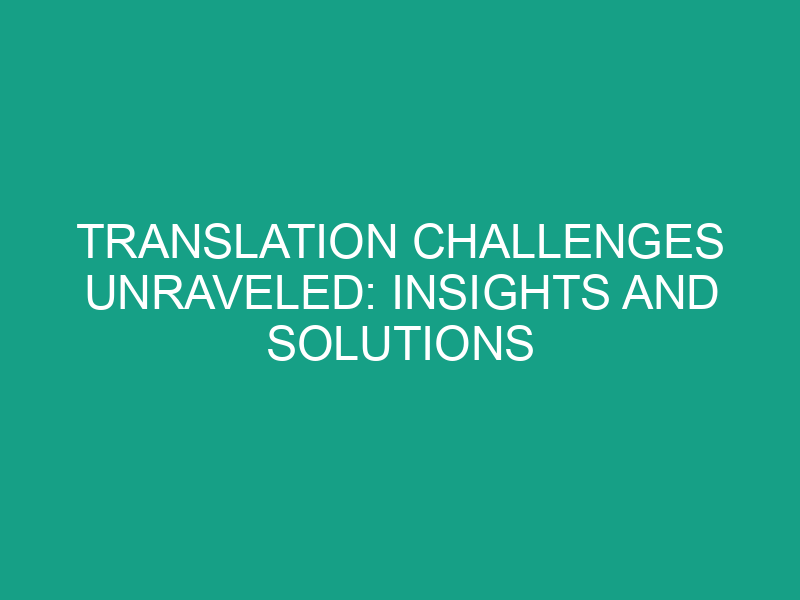
The intricate process of translation is much more than mere word substitution from one language to another; it’s an art form that requires deep understanding, cultural sensitivity, and linguistic expertise. Despite the critical role translation plays in global communication, it’s fraught with challenges that can complicate the conveyance of the original message’s intent, tone, and nuance.
This article delves into the common challenges faced in the translation process, offering insights and practical solutions to ensure accurate, effective communication across linguistic and cultural barriers.
Understanding Linguistic Nuances
One of the most significant hurdles in translation is capturing the essence of linguistic nuances—idioms, colloquialisms, and cultural references that don’t have direct equivalents in other languages.
Insight: Cultural Context is Key
Understanding the cultural context behind the language is crucial. Professional translators immerse themselves in both the source and target cultures to grasp these nuances more accurately.
Solution: Employ Native Translators
Utilizing native speakers or translators with extensive experience in the target culture can help ensure that translations resonate with the intended audience, preserving the original message’s subtlety and context.
Navigating Technical Terminology
Technical, legal, medical, and scientific translations require precise terminology. A minor error can lead to misunderstandings with potentially significant consequences. At this website
Insight: Specialization is Essential
Translation in specialized fields goes beyond linguistic proficiency; it requires in-depth knowledge of the subject matter.
Solution: Engage Subject Matter Experts
Engaging translators who are also subject matter experts or working closely with them can significantly enhance the accuracy of technical translations. Glossaries and translation memory tools can ensure consistency across documents.
Dealing with Multiple Meanings and Polysemy
Words with multiple meanings present a challenge, as the context determines the correct interpretation. Polysemy, where a single word carries multiple meanings that are related by extension, adds another layer of complexity.
Insight: Contextual Clarity
A thorough understanding of the context in which a word is used is paramount to choose the correct meaning during translation.
Solution: Contextual Analysis and Back-Translation
A detailed analysis of the context and, when necessary, back-translation—a process where a translated text is translated back into the original language by another translator—can help verify accuracy and select the appropriate meanings.
Maintaining the Tone and Style
Preserving the author’s tone, style, and intent in translation can be as crucial as the accurate translation of words and phrases.
Insight: The Translator’s Sensitivity
A translator must be sensitive to the original text’s tone and style, understanding the author’s intent and the effect on the target audience.
Solution: Creative and Adaptive Translation
Translators may need to employ creative translation techniques, adapting phrases and structures to maintain the original’s tone and style in the target language. This might include the use of equivalent idioms or culturally resonant expressions.
Overcoming Structural and Grammatical Differences
Languages differ significantly in their syntax, grammar, and sentence structure, posing challenges in maintaining the fluidity and readability of the translated text.
Insight: Flexibility in Translation
Literal translation often leads to awkward or unclear sentences in the target language. Flexibility and a focus on conveying meaning rather than direct word-for-word translation are essential.
Solution: Dynamic Equivalence
Employing dynamic equivalence, where the translator seeks to convey the thought or emotional content of the original using the linguistic and cultural expressions of the target language, can result in more natural, comprehensible translation.
Addressing Cultural Differences and Sensitivities
Cultural sensitivities can influence the reception of a translated message, where certain concepts or expressions in the source language may be inappropriate or offensive in the target culture.
Insight: Cultural Intelligence
A deep understanding of both source and target cultures allows translators to navigate potential cultural pitfalls, ensuring that translations are appropriate and respectful.
Solution: Cultural Adaptation and Consultation
Cultural adaptation, where content is modified to suit the target culture’s sensibilities, coupled with consultation with cultural experts, can help mitigate issues related to cultural differences and sensitivities.
The Role of Technology in Addressing Translation Challenges
While technology, particularly AI and machine translation, has made significant strides, it cannot fully replace the nuanced understanding and cultural awareness of a skilled human translator. However, it can serve as a valuable tool in addressing some of the challenges mentioned.
Solution: Complementary Use of Technology
Leveraging technology for initial translations, glossary management, and workflow efficiency, while relying on human expertise for nuanced understanding and cultural adaptation, represents a balanced approach to overcoming translation challenges.
Conclusion
Translation is a complex, nuanced process that requires more than just linguistic skills; it demands an in-depth understanding of cultural nuances, technical terminologies, and the subtleties of human communication. By employing native speakers, engaging subject matter experts, and utilizing a blend of technology and human expertise, it’s possible to navigate the myriad challenges that translation presents.